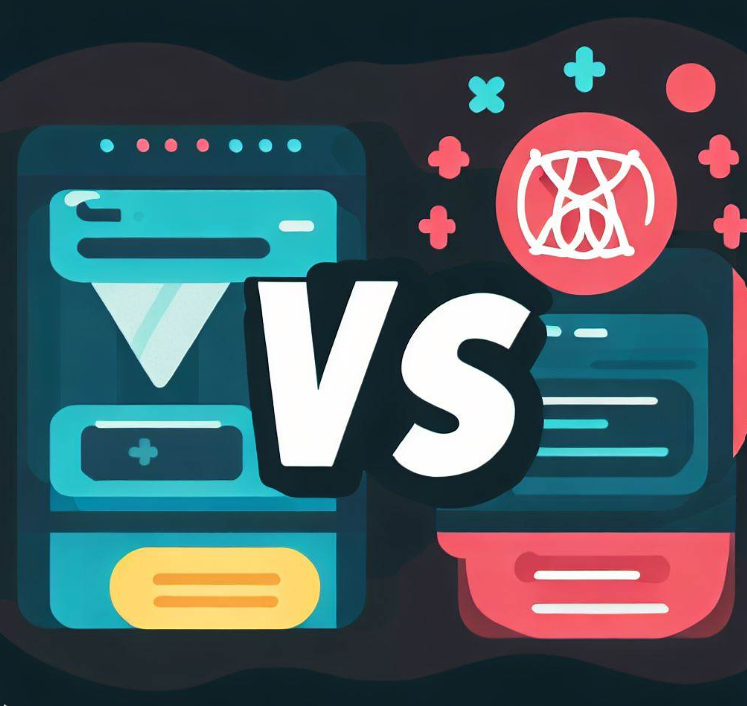- Webflow vs. WordPress?
- Ease of use
- Customization
- Coding
- SEO capabilities
- Hosting and pricing
- Pros and Cons: Webflow vs. WordPress
- Our recommendations
- Next steps
- FAQ—Webflow vs. WordPress
You have a decision to make: Webflow vs. WordPress.
Are you a designer, a developer, or a blogger? Are you budget-conscious? Do you want ease of use or complete control over your website’s design?
Both platforms deliver professional results. Both platforms have a learning curve.
But which to choose for your own project?
I’ll walk you through the pros and cons of each platform.
The choice might be more difficult than you think.
Let’s see if I can make it easier for you.
Webflow vs. WordPress?
WordPress was launched in 2003. It began as a blogging platform. But 20 years of constant evolution has made WordPress the most popular Content Management System (CMS) on the internet. It’s well known that WordPress powers over 40% of websites globally. Wow.
Webflow is ten years younger than WordPress but has also evolved over time. Beginning as a no-code web design tool, Webflow has developed CMS features, although they are not as extensive as those of WordPress.
WordPress and Webflow have these features and more in common. But there are distinct differences in how they operate, how much they cost, and where they are hosted.
Let’s examine this by comparing the two side-by-side.
Ease of use
Webflow is designed as a visual interface. “No-code” apps like Webflow require no programming. They have a drag-and-drop approach to putting webpage elements on the screen. This is an intuitive way for professional designers to work. Beginners with few design skills may find this approach complex. There is a definite learning curve.
WordPress, in its basic form, is built to make it easy for a novice blogger to get started quickly. The WordPress user interface is a bit cryptic. Again, if your web design calls for more complex tasks than simply starting a blog, there is a learning curve associated with it.
Customization
Both platforms offer plugins as extensions to the basic features. In addition, both support themes (Webflow templates) that make it easy to change the look and feel of your website.
Over the years, WordPress has fostered an open-source developer community that offers thousands of plugins and themes, both free and paid. There is a plugin for just about anything you want to accomplish.
Webflow has a much smaller choice of plugins and templates than the WordPress community offers. Combining this with its no-code approach, feature customization is more difficult to achieve. However, with a visual CSS and HTML interface, customizing the initial design is possible without writing any code.
Integrations are massive in WordPress, much more limited on Webflow. Each platform has its own marketplace to shop for themes (templates), plugins, and integrations.
Coding
Coding is possible in WordPress but not in Webflow. WordPress is written in HTML, CSS, and PHP. Other languages, such as JavaScript, are also available. Developer-level knowledge of coding is essential to modify WordPress or create a theme or plugin yourself. Still, it is possible, and this makes WordPress the more customizable of the two platforms.
SEO capabilities
Webflow has built-in SEO tools, making it possible to optimize your website’s SEO settings without an additional plugin. But Webflow doesn’t offer SEO plugins if there is something you need that the closed system doesn’t provide.
WordPress essentially requires the use of a plugin to optimize the SEO settings for your site, but many free, freemium, and paid plugins are available which do a great job. WordPress has the most customizable SEO settings because of the plugin architecture.
Hosting and pricing
WordPress comes in two varieties for hosting. The first is wordpress.com, which is fully hosted. There is a free subscription tier, so you can host, design, and publish your WordPress website free of charge without worrying about third-party hosting services.
The second variety is wordpress.org. Here is where you can download WordPress itself, plugins, themes, and view documentation—all for free. You host the WordPress installation yourself or on commercial web hosting services. Hosting prices vary widely. Shop wisely.
Webflow provides paid integrated hosting for the sites you create, although you can export your site and have it hosted elsewhere, possibly at a lower price—or even for free. Webflow has three pricing tiers: free, $12 a month, and $24 a month. Each tier offers progressively more features for a higher price.
RECOMMENDED ARTICLE: How to Host Webflow Yourself
Pros and Cons: Webflow vs. WordPress
You’ve gotten a good overview of these platforms. Now, let’s list the pros and cons of each to help you refresh your memory and make an informed decision.
Webflow pros
- Visual design built in.
- Integrated hosting.
- No-code interface.
- Built-in SEO tools.
- No plugins required.
Webflow cons
- Subscription costs may be more expensive in the long run.
- Steep learning curve.
- Limited community and marketplace.
- No e-commerce support.
- Limited control over hosting unless you export and host elsewhere.
WordPress pros
- Free and open-source software.
- Extremely customizable.
- Huge community and marketplace.
- E-commerce integration.
- Complete control over hosting.
WordPress cons
- Big learning curve beyond basic functions.
- Performance must be optimized, often with plugins.
- Security concerns arise because widespread popularity attracts hackers.
- Maintenance must be ongoing since updates occur regularly.
- Not all plugins and themes are reliably coded. Shop carefully.
Our recommendations
Choose Webflow if…
- You want an integrated design and hosting experience.
- You want a true no-code platform.
- You intend to design on a no-code platform and host elsewhere.
- Your website is not involved with e-commerce.
Choose WordPress if…
- You are budget conscious.
- You are a blogger intending to have an extensive blog presence.
- You want complete control over design and hosting.
- You need an integrated e-commerce solution.
Next steps
One excellent option not much discussed in this article is to export your Webflow site and host it on a fast, secure web host like our service, Tiiny.host.
You can also export a WordPress site to speedy and secure static web pages using a Static Site Generator (SSG). Then host your site using the professional features of Tiiny.host.
RECOMMENDED ARTICLE: Static Site Generators for WordPress
Visit Tiiny.host for the simplest way to host your static site or exported Webflow project.
Still have questions?
Reach out to Tiiny.host/help to contact our awesome customer service people. They’re glad to answer questions about this article, web hosting, or just about anything internet-related. We’re available now by email and chat.
FAQ—Webflow vs. WordPress
What is the main difference between Webflow and WordPress?
The main difference is that Webflow is a visual web design tool with integrated hosting, while WordPress is open-source CMS software requiring separate hosting. Webflow is geared more towards designers and has a steeper learning curve, while WordPress offers more features and customization for developers.
Does Webflow allow for customization and add-ons?
Webflow allows for custom CSS and HTML but does not have the same ecosystem of plugins and extensions as WordPress. You have less control over adding advanced functionality in Webflow.
Is Webflow good for blogging?
Webflow has basic blogging capabilities, but WordPress is better suited for serious blogging with features like post scheduling, categories, discussion forums, and better SEO options out of the box. Webflow focuses more on overall site design.



